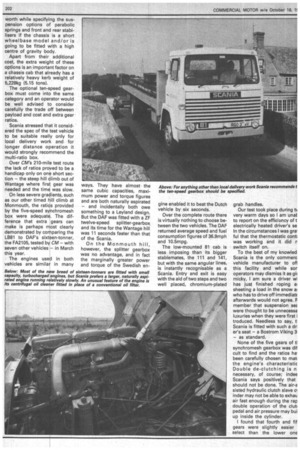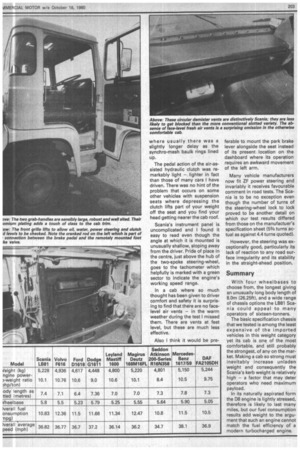Chassis options broaden appeal
Page 203

Page 204

Page 205

If you've noticed an error in this article please click here to report it so we can fix it.
Scania's 16-tonner lacks turbocharged fuel efficiency, but four wheelbases are offered, the cab is super strong and Tim Blakemore reports that it's a driver's vehicle
THE UK sixteen-ton market npetition has hotted up conerably these last few months. reral manufacturers have induced new models compel) established makers to look their laurels. One of these ablished names is that of Scaand though its main impact the market has historically en obtained with its wyweight tractive units, the mpany's two-axle rigids )uld not be overlooked.
he vehicle we tested over Vs Welsh route for ddleweights was the one at bottom of Scania's weight ige for this country — the 81. Its naturally aspirated 7.8e engine delivers 120kW II bhp) at 2,400rpm and has a ak torque rating of 516Nm 1011aft).
3oth these figures are about erage for a UK specification :teen-tonner. It came as nc rprise, therefore, to find that 3 fuel consumption and avere speed over our test route is neither the best nor the
worst of those we have tested.
We changed our route slightly for the Scania test because the A4137 at Marstow was closed for roadworks. The diversion took us further up the A40 and then left on to the A49, passing the junction where we normally join that road. This added 5km (3.1 miles) to the test route and while it avoided the short steep climb on the A4137 it provided a longer, more gentle gradient on the A40, making the net effect on our results negligible.
Unlike so many other importers, Scania ofters a number of options for the LB81 including a choice of three rear-axle ratios. Our test vehicle was fitted with the standard 4.86:1 ratio, giving it a calculated maximum gradeability of 1 in 5.8 (17.2 per cent) and a road speed of 95km/h (59mph) when the tachometer needle was just entering the red sector at 2,400rpm.
In practice we found Scania's claimed gradeability to be very much on the modest side, for the fully laden LB81 restarted easily on the 1 in 5 gradient at MIRA. Indeed, it pulled away so easily that I was tempted to try a restart on the 1 in 4 test hill, but in deference to the vehicle's clutch (and the Scania engineer's blood pressure) decided against it. The park-brake performance was equally impressive, holding the four-wheeler with ease on a 1 in 3 gradient and recording a peak deceleration of 0.65g from 32km/h (20mph).
The Scania really excelled on the ride and handling circuit at MIRA. A vehicle such as this with a long wheelbase and a flat platform body giving a low centre of gravity can be expected to have good ride characteristics. However, our test vehicle also had a basic specification suspension with semi-elliptic multi-leaf springs, no anti-roll bars and shock absorbers only on the front axle, so I was expecting to be bounced around a bit. The fact that this did not happen indicates that it is probably only worth while specifying the suspension options of parabolic springs and front and rear stabilisers if the chassis is a short wheelbase model and/or is going to be fitted with a high centre of gravity body.
Apart from their additional cost, the extra weight of these options is an important factor on a chassis cab that already has a relatively heavy kerb weight of 5,228kg (5.15 tons).
The optional ten-speed gearbox must come into the same category and an operator would be well advised to consider carefully the trade off between payload and cost and extra gear ratios.
Scania stressed that it considered the spec of the test vehicle to be suitable really only for local delivery work and for longer distance operation it would strongly recommend the multi-ratio box.
Over CM'S 210-mile test route the lack of ratios proved to be a handicap only on on short section — the steep hill 4limb out of Wantage where first gear was needed and the time was slow.
On less severe gradients, such as our other timed hill climb at Monmouth, the ratios provided by the five-speed synchromesh box were adequat The difference that extra gears can make is perhaps niost clearly demonstrated by co paring the LB81 to DAF's sixteen-tanner, the FA2105, tested by CM— with seven other vehicles — in March this year.
The engines us$1 in both vehicles are simile in many ways. They have almost the same cubic capacities, maximum power and torque figures and are both naturally aspirated — and incidentally both owe something to a Leyland design. But the DAF was fitted with a ZF twelve-speed splitter-gearbox and its time for the Wantage hill was 11 seconds faster than that of the Scania.
On the Monmouth hill, however, the splitter gearbox was no advantage, and in fact the marginally greater power and torque of the Swedish en gine enabled it to beat the Dutch vehicle by six seconds.
Over the complete route there is virtually nothing to choose between the two vehicles. The DAF returned average speed and fuel consumption figures of 36.9mph and 10.5mpg.
The low-mounted 81 cab is less imposing than its bigger stablemates, the 111 and 141, but with the same angular lines, is instantly recognisable as a Scania. Entry and exit is easy with the aid of two steps and two well placed, chromium-plated grab handles.
Our test took place during very warm days so I am unaL to report on the efficiency of t electrically heated driver's se In the circumstances I was gra, ful that the thermostatic conti was working and it did r switch itself on.
To the best of my knowled Scania is the only commerc vehicle manufacturer to oft this facility and while sor operators may dismiss it as gil micky, I am sure a driver wl has just finished roping al sheeting a load in the snow al who has to drive off immediatE afterwards would not agree. F member that suspension se were thought to be unnecessa luxuries when they were first i traduced. Needless to say, t Scania is fitted with such a dr el.'s seat — a Bostrom Viking 3 — as standard.
None of the five gears of tl synchromesh gearbox was dif cult to find and the ratios ha' been carefully chosen to mat the engine's characteristic Double de-clutching is n necessary, of course; indee Scania says positively that should not be done. The air-a sisted hydraulic clutch slave c+ inder may not be able to exhau air fast enough during the rap double operation of the cluti pedal and air pressure may bui up inside the cylinder.
I found that fourth and fif gears were slightly easier select than the lower one where usually there was a slightly longer delay as the synchro-mesh baulk rings lined up.
The pedal action of the air-assisted hydraulic clutch was remarkably light -. lighter in fact than those of many cars I have driven. There was no hint of the problem that occurs on some other vehicles with suspension seats where depressing the clutch lifts part of your weight off the seat and you find your head getting nearer the cab roof.
Scania's instrument panel is uncomplicated and I found it easy to read even though the angle at which it is mounted is unusually shallow, sloping away from the driver. Pride of place in the centre, just above the hub of the two-spoke steering-wheel, goes to the tachometer which helpfully is marked with a green sector to indicate the engine's working speed range.
In a cab where so much thought has been given to driver comfort and safety it is surprising to find that there are no facelevel air vents in the warm weather during the test I missed them. There are vents at feet level, but these are much less effective.
Also I think it would be pre ferable to mount the park brake lever alongside the seat instead of its present location on the dashboard where its operation requires an awkward movement of the left arm.
Many vehicle manufacturers now fit ZF power steering and invariably it receives favourable comment in road tests. The Scania is to be no exception even though the number of turns of the steering-wheel lock to lock proved to be another detail on which our test results differed from those on the manufactuer's specification sheet (53/4 turns actual as against 4.4 turns quoted).
However, the steering was exceptionally good, particularly its lack of reaction to any road surface irregularity and its stability in the straight-ahead position.
Summary With four wheelbases to choose from, the longest giving an unusually long body length of 8.0m (26.25ft), and a wide range of chassis options the LE(81 Scan ia could appeal to many operators of sixteen-tonners.
The basic specification chassis that we tested is among the least expensive of the imported vehicles in this weight category yet its cab is one of the most comfortable, and still probably the strongest, of any on the market. Making a cab so strong must inevitably increase unladen weight and consequently the Scania's kerb weight is relatively high a factor that may deter operators who need maximum payload.
In its naturally aspirated form the D8 engine is lightly stressed, therefore is likely to last many miles, but our fuel consumption results add weight to the argument that such an engine cannot match the fuel efficiency of a modern turbocharged engine.




























































































































































































































































































